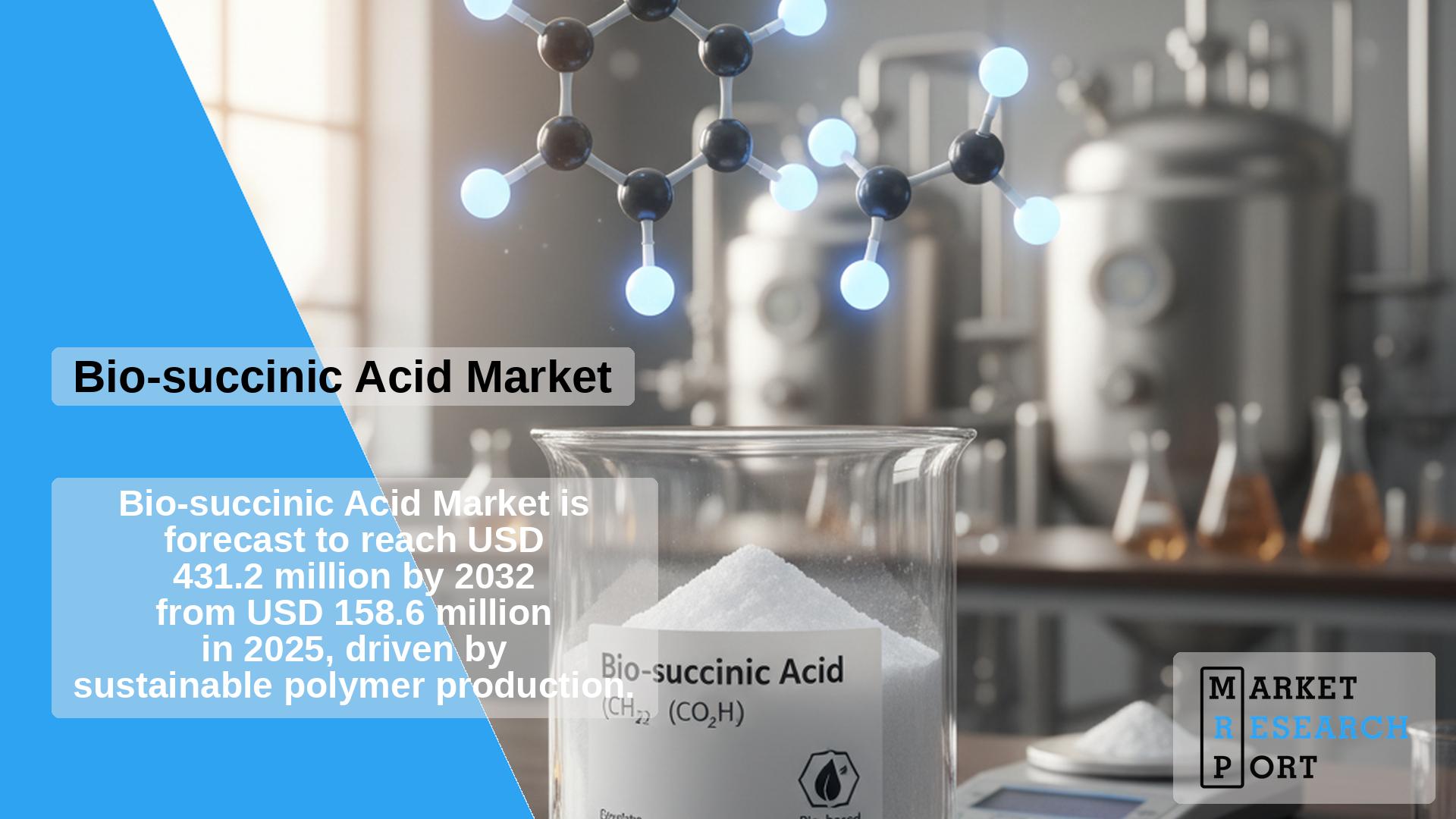
The global bio-succinic acid market size reached USD 156.84 million in 2025 and is projected to achieve USD 308.25 million by 2030, growing at a CAGR of 13.2% from 2025 to 2030. This growth is fueled by the rising preference for eco-friendly and non-toxic products that are safe for humans and sustainable for the environment.
The market reflects increasing competition among global and regional manufacturers with a solid focus on technological innovation and sustainable development. Growing applications across automotive, packaging, consumer product, and healthcare industries are expected to accelerate overall growth.
Succinic acid plays an essential role across multiple industries such as food, cosmetics, and pharmaceuticals, and is also naturally produced in the human body. Bio-succinic acid offers a safer and environmentally conscious alternative to petrochemical variations while also supporting advancements in bioplastics and sustainable chemicals.
The transition from conventional petrochemical processes to renewable feedstock-based manufacturing has strengthened the adoption of bio-succinic acid. It not only supports carbon footprint reduction but also enables effective waste utilization, promoting a circular production model aligned with global environmental goals.
The market exhibits moderate consolidation, featuring leading multinational companies such as BASF SE, Roquette Frères, DSM, and Mitsubishi Chemical Corporation, alongside emerging producers like Myriant Corporation and Kawasaki Kasei Chemicals. Ongoing R&D efforts in bio-based chemistry and microbial fermentation continue to drive technological evolution in the industry.
Governmental agencies and policy frameworks—such as the U.S. EPA and the European Commission—play a major role in promoting bio-based production standards, ensuring safety, and reinforcing global sustainability mandates. Collaborative ventures among key manufacturers are increasingly contributing to innovation, efficiency, and large-scale commercialization.
The 1,4-butanediol (BDO) application remained dominant with a 35.2% share in 2025 and is anticipated to grow consistently. Demand is primarily driven by its use in producing polyurethane, tetrahydrofuran (THF), polybutylene terephthalate (PBT), and other engineered polymers. Increasing consumption of bio-based BDO for plastics and coatings underlines its expanding industrial relevance.
The PBS/PBST segment captured the second-largest share, representing 18.9% in 2025. Growing interest in biodegradable packaging materials and sustainable alternatives to conventional plastics is boosting its growth potential.
The industrial sector led the market in 2025, contributing 42.3% of total revenue. This dominance stems from rising applications in manufacturing adhesive materials, coatings, lubricants, sealants, and resins. Widespread production of performance polymers and composites using bio-succinic acid reflects the ongoing shift toward greener industrial chemistry.
The pharmaceutical segment continues to grow, accounting for nearly 17.8% of global revenue in 2025. Its applications include pharmaceutical intermediates and active ingredients for cardiovascular and metabolic health formulations. Demand from this sector remains strong amid the ongoing push for natural and bio-based formulations.
North America and Europe remain leading regions, supported by regulatory mandates and large-scale investments in renewable and bio-based materials. Asia Pacific continues to experience rapid advancement, particularly across China, India, and Japan, driven by rising local bio-manufacturing capacities.
The U.S. market continues to expand, supported by strong adoption in pharmaceutical, food & beverage, and personal care applications, coupled with an increasing preference for bio-derived chemicals.
Europe led the market in 2025, driven by efforts to minimize fossil fuel dependency and promote bio-based alternatives. Germany holds the strongest presence, prioritizing the transition to low-carbon chemical production. France and the UK are accelerating bio-succinic acid adoption through supportive policy reforms and cost-efficient process improvements.
Asia Pacific represents the fastest-growing regional market. Supportive government initiatives and expanding research investments in China and India are stimulating production scale and capacity growth. The region’s continuously developing bioplastics sector further enhances regional consumption levels.
Markets in Brazil and Argentina are benefiting from national sustainability programs and favorable climate policies. Brazil’s ongoing expansion in renewable energy and support under the RenovaBio policy bolster its market standing across bio-based chemicals.
MEA is witnessing early-stage adoption supported by technology partnerships and government-led diversification initiatives. Regional investments in biotechnology hubs are expected to enhance output within the next five years.
The competitive environment is defined by strategic collaborations, licensing agreements, and advancement in green chemistry technologies. Companies continue to focus on product optimization and sustainable supply chain integration.
| Report Attribute | Details |
| Market size value in 2025 | USD 156.84 million |
| Revenue forecast in 2030 | USD 308.25 million |
| Growth rate | CAGR of 13.2% from 2025–2030 |
| Historical data | 2019–2024 |
| Forecast period | 2025–2030 |
| Quantitative units | Volume in kilotons, revenue in USD million, and CAGR from 2025 to 2030 |
| Report coverage | Volume & revenue forecast, company ranking, competitive landscape, growth catalysts, and market trends |
| Segments covered | Application, end-use, region |
| Regional scope | North America; Europe; Asia Pacific; Central & South America; Middle East & Africa |
| Country scope | U.S.; Canada; Mexico; Germany; UK; France; Italy; Spain; China; India; Japan; South Korea; Thailand; Brazil; Argentina; Saudi Arabia; South Africa |
| Key companies profiled | BASF SE; DSM; Roquette Frères; BioAmber; Myriant Corporation; Kawasaki Kasei Chemicals; Mitsui & Co., Ltd.; Mitsubishi Chemical Corporation |
The report analyzes volume and revenue expansion across countries and regions, outlining trends across major sub-segments from 2019 to 2030. Market segmentation is categorized by application, end-use, and region as follows:
What is the size of the global bio-succinic acid market in 2025?
The market was valued at USD 156.84 million in 2025.
How fast is the bio-succinic acid market expected to grow?
The market is anticipated to grow at a CAGR of 13.2% from 2025 to 2030, reaching USD 308.25 million by 2030.
Which application segment leads the market?
The 1,4-butanediol (BDO) segment held the largest share of 35.2% in 2025, primarily driven by its use in producing polyurethanes, THF, and bio-based engineering plastics.
Who are the key companies operating in the market?
Major players include BASF SE, DSM, Roquette Frères, BioAmber, Myriant Corporation, and Mitsubishi Chemical Corporation.
What factors are driving market growth?
Increased adoption of bio-based products, environmental sustainability initiatives, and rising demand across plastics, pharmaceuticals, and industrial materials are key growth drivers.